#regulatory T cell
Text


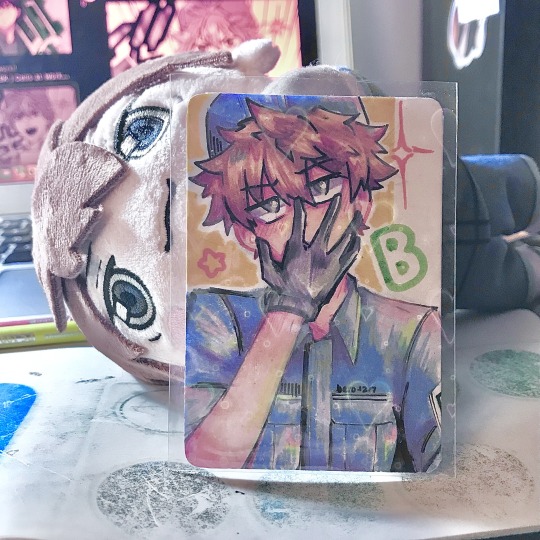
older CaW art I forgot to post… (around 3 months ago 😭)
#digital art#procreate#my art <3#rkgk#fanart#cells at work fanart#cells at work#はたらく細胞#hataraku saibou#hataraku saibou fanart#killer t cell#helper t cell#regulatory t cell#nk cell#eosinophil#dendritic cell#macrophage#B cell
74 notes
·
View notes
Text
Propaganda!


The regulatory T cells (Tregs), formerly known as suppressor T cells, are a subpopulation of T cells that modulate the immune system, maintain tolerance to self-antigens, and prevent autoimmune disease.
A phagosome is a vesicle formed around a particle engulfed by a phagocyte via phagocytosis. Phagosome formation is crucial for tissue homeostasis and both innate and adaptive host defense against pathogens.
#tournament poll#polls#wikipedia#cells of the human body#science tournament#image description in alt#regulatory T cell#phagosome
38 notes
·
View notes
Text

Lymphocyte gang rise up!
#cells at work#hataraku saibou#cells at work fanart#b cell#killer t cell#nk cell#regulatory T cell#helper T cell#group#my art
339 notes
·
View notes
Text
T cells in a nutshell
#cells at work#hataraku saibou#helper t cell#regulatory t cell#what is bro yapping about🤦♀️🤦♀️#this audio is so funny
26 notes
·
View notes
Text
Human AU names for the cells :
U1146 : Shirogane
U-4989 : Yashiro
U-2626 : Toshiro
U2048 : Kenshiro
U2001 : Mashiro
AE3803 : Akari
AA5100 : Akane
Killer T : Kenta
NK cell : Nikki
Macrophage : Maria
Helper T : Hiroto
Regulatory T : Reina (the name with R and T in the middle didn't please me so I half assed it haha)
B cell : Banri
Platelet : Hinako (it was hard to find anything cute with a P so I gave up and found a cute name instead)
Eosinophil : Koizumi (name starting with ko because : Kōsankyū
Basophil : Kohei (another name starting by ko because : Kōenkikyū)
Mast cell : Masumi (because Masuto saibou)
Dendritic cell : Juichi (because Jujo saibou)
Basic cell/Cell boy : Nobu
Cancer cell : Haneki (referring to the moment he had wings)
It's pure amateurish. Do you have your own version? If so, I'd be glad to see it!
#hataraku saibou#cells at work#wbc#rbc#U1146#AE3803#killer t#macrophage#helper t cell#regulatory t cell#eosinophil#basophil#b cell#platelet#AA5100#Mast cell
19 notes
·
View notes
Text
POV: art block still lasts but u don't want the CAW fandom to think you're dead so you decide to practice drawing with ur fav girlboss so you will have something to post (but the practice turns out better than ur actual drawings so you make a cute background too)



#cells at work#hataraku saibou#regulatory t cell#I swear to god im straight then i see her#girlboss#the background took longer than the actual drawing lol
124 notes
·
View notes
Text
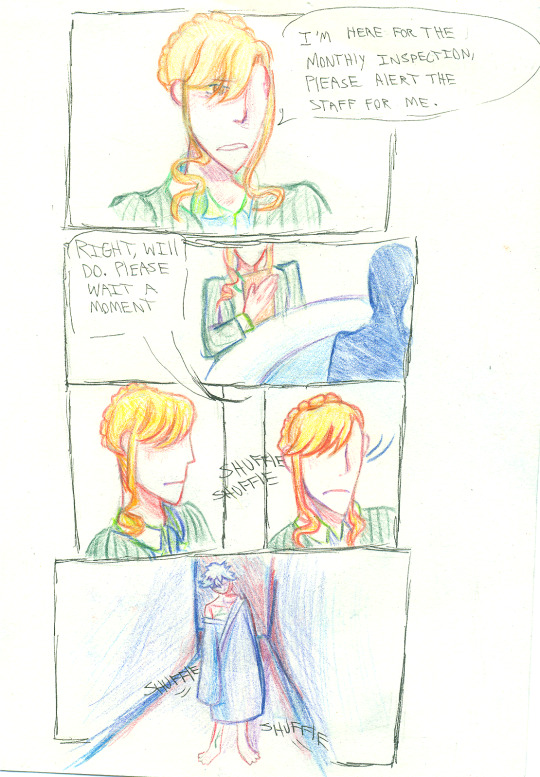
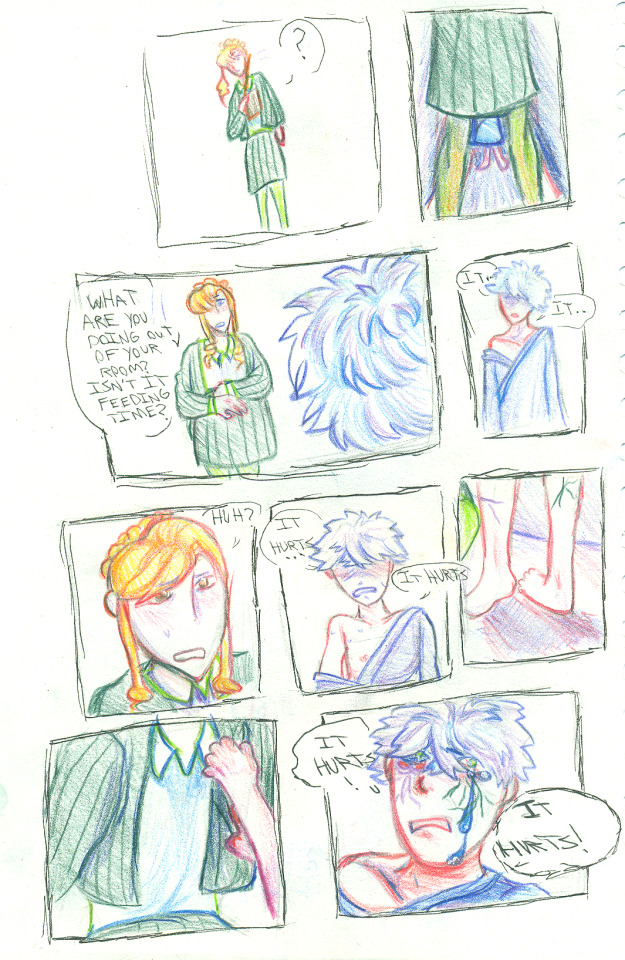
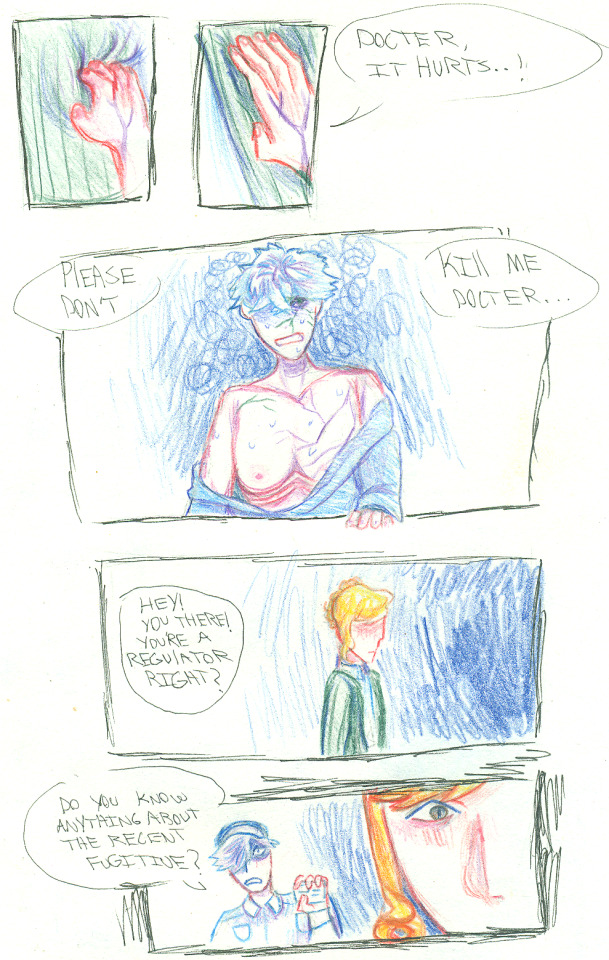
more stuff from my caw au.
riku and regulatory t have a interesting relationship, t is afraid of riku but not because hes riku but because what he represents for her
#derealization#my art#my post#fanart#cells at work#riku#hataraku saibō#hataraku saibou#regulatory t cell#cells at work season two#cells at work wbc#white blood cell#caw cancer cell#hataraku saibou cancer cell#cells at work cancer cell#comic#story comic#coloured comic
8 notes
·
View notes
Text
The opportunity within the regulatory T-cell therapies market is projected to grow at an annualized rate of ~45%, till 2035
Roots Analysis has done a detailed study on “Global Regulatory T-Cell (Tregs) Therapies Market”, covering key aspects of the industry’s evolution and identifying potential future growth opportunities.
Given the various benefits offered, including high target specificity, customization potential and ability to generate immunological memory, regulatory Treg cell therapies have garnered significant attention among key industry stakeholders for the treatment of various oncological and non-oncological disease indications.
Key Market Insights
§ More than 150 industry players across the world are presently engaged in evaluating the potential of nearly 300 next generation immune checkpoint modulators for the treatment of multiple disease indications
§ The pipeline features a variety of marketed / clinical stage therapies, targeting a number of different types of immune checkpoints and being investigated for administration via different routes
§ In the last few years, over 600 clinical studies of various types of immune checkpoint modulation-based therapies, involving nearly 90,000 patients across different centers / hospitals, have been initiated worldwide
§ In the pursuit of obtaining an edge within this emerging and highly competitive market landscape, developers are actively exploring the therapeutic potential of novel immune checkpoints, beyond PD-L1, PD-1 and CTLA-4
§ Over time, big pharma players have initiated product development programs focused on immune checkpoint modulation for treating various oncological indications, investing significant capital, time and effort
§ Several organizations have extended financial support to aid research efforts in this domain; the current focus is on investigation of novel immune checkpoint pathways / targets
§ The growing interest in this field is also reflected by the 120+ partnerships have been signed in the last two years, involving both international and indigenous stakeholders
§ The future market, based on the revenue generation potential of marketed and late stage therapies, is anticipated to be distributed across different disease areas, mechanisms and key geographical regions
§ In the long term, the opportunity is likely to be segmented across diverse therapeutic modalities, immune checkpoint targets and routes of administration
One of the key objectives of the report was to estimate the existing market size and identify potential growth opportunities associated with Treg cell therapies, over the coming decade. The report also includes likely sales forecasts of Treg cell therapies that are in the mid to late stages of development.
To request a sample copy / brochure of this report, please visit this
https://www.rootsanalysis.com/reports/regulatory-t-cell-therapies-market/request-sample.html
Table of Contents
1. Preface
2. Executive Summary
3. Introduction
4. Current Market Landscape
5. Therapy Profiles
6. Clinical Trial Analysis
7. Partnerships and Collaborations
8. Funding and Investment Analysis
9. Porter’s Five Analysis
10. Company Profiles
11. Market Sizing and Opportunity Analysis
12. Conclusion
13. Executive Insights
14. Appendices
For more information, please visit https://www.rootsanalysis.com/reports/regulatory-t-cell-therapies-market.html
You may also be interested in the following reports :
1. CD47 Targeting Therapeutics Market: Industry Trends and Global Forecasts, 2021-2030
2. Antibody Drug Conjugates Market (6th Edition): Industry Trends and Global Forecasts, 2021-2030
3. Novel T-Cell Immunotherapies Market: Industry Trends and Global Forecasts, 2021-2030
4. TIL-based Therapies Market: Industry Trends and Global Forecasts, 2021-2030
About Roots Analysis
Roots Analysis is one of the fastest growing market research companies, sharing fresh and independent perspectives in the bio-pharmaceutical industry. The in-depth research, analysis and insights are driven by an experienced leadership team which has gained many years of significant experience in this sector. If you’d like help with your growing business needs, get in touch at [email protected]
Contact Information
Roots Analysis Private Limited
Ben Johnson
+1 (415) 800 3415
+44 (122) 391 1091
#Treg cell therapies#Global Regulatory T-Cell (Tregs) Therapies Market#Tregs Therapies Market#RootsAnalysis
0 notes
Text
Here, I will give you, the reader, clear enumerations where SARS Cov 2 is unlike a common cold.
SARS Cov 2 triggers a unique, long-lived inflammatory overreaction unseen in Sepsis and influenza.
SARS Cov 2 sends T cells into the brain while lethal influenza does not.
SARS Cov 2 directly causes autoimmunity by reprogramming a special type of T cell called the T regulatory cell, which has never been observed before.
The human genetic line has not propagated any sarbecovirus elements therefore never has faced Sarbecovirus infection to the extent to evolutionarily adapt, except in the unlikely theoretical possibility of extremely negative selection (meaning infected humans did not create progeny.)
There are more exceptional facets but these are simple and digestible. There is also more to write about but I must make a confession. The status quo has morphed in such a way as to browbeat scientists into disavowing a harsh reality in order to acquiesce to corporate and business interests. As we see the average life expectancy decline, we have been left intellectually out in the cold. The truth tellers have been assaulted and crushed, and the individuals that comprise the public, in denial, will put off the realization of a below 70s life expectancy until each one approaches retirement in piecemeal, just as all the grains of sand in an hourglass do not fall at once.
93 notes
·
View notes
Text
Retroviruses got me fucked up
@moosemonstrous are u ready for a dissertation? I hope so.
people who followed me for art I'm so sorry
ALRIGHT so we're gonna cover a couple areas.
General information about retroviruses.
Details about The Corruption and theories about how it works inside the body.
SPECIFICALLY ROBBIES viral weird shit. Cause what he has going on is even more fucked up than normal fucked up. Fucked up squared.
Me ranting about skin necrosis and why I shouldn't have just. Thown it in there because I thought it would look fucky wucky.
GENERAL INFORMATION ABOUT RETROVIRUSES:
As most people know, a virus is a cell that enters the body of a host and alters its DNA to turn that hosts cells into virus making factories. This is what allows viruses to duplicate and spread through the body so quickly. But whats that? 'What makes retroviruses different from other viruses?' I hear you asking? WELL EXCELLENT QUESTION THATS A PERFECT PLACE TO START. A retrovirus is different because its method of self duplication involves an enzyme called reverse transcriptase. This makes retroviral infection PERMANENT. Even if the virus is defeated by the immune system, those changes stick around. The phrasing used was 'ipso facto mutagenic' meaning 'by the fact itself/inevitable'.
...Which is kinda metal honestly I want it on a tee shirt (definetly not thinking of Amadeus saying that to Robbie as he tries his best to explain theres no way to undo whats going on with him. nahhhh angst don't got a hold on me like that [<- vibrating])
'Ohhh but if those genetic changes never go away, doesn't that mean that those viruses will get passed on through peoples children?' ASKING SUCH GOOD QUESTIONS TODAY MY MUTUAL BECAUSE THE ANSWER IS YES. Once a retrovirus codes itself into a hosts gnome, its called a provirus (pro gamer move right there) Fun (not fun) fact around 8% of the human gnome is made of proviruses. These are called endogenous viruses, and for the most part they just kinda sit there and stay dormant. TERRIFYINGLY, other viral infections can trigger these endogenous viruses out of dormancy. As for what actually causes a provirus to go dormant uhhhhhhhh I dunno. Couldn't find an answer in my research someone make me look stupid with an answer please because I wanna know.
Ok now lets talk about the immune system a little bit. There are a few different kind of cells at work (hehehehehe) that help to fight viruses and other infections in the body. The first are Cytotoxic T cells or Killer T Cells. These are the cells that directly destroy cells displaying genetic patterns they recognize as bad. Next we have CD+4 Cells (Helper T Cells) which act as a library that stores information about how to identify an infected cell, and shares that information with other Killer T cells once one figures it out. Then there are the Regulatory T cells which suppress your immune responses to maintain homeostasis. They're what (USUALLY) stops your immune system from killing you while trying to clear a virus. Last there are Macrophage. CELLS AT WORK MAID MILFS- I mean cells that clear the debris that remain after the Killer T Cells are done destroying them.
Retroviruses have two primary ways of either side-stepping the immune system or just. Overwhelming it completely. Acutely transforming retroviruses do just that. They reproduce too quickly for Killer T cells to destroy them all and exhaust the system. The second type are called Non Acute Retroviruses. They camouflage viral particles as immune cells to suppress the immune system. For example, HLTV-1 is a retrovirus that disguises itself as a Regulatory T cell to artificially suppress the immune response thats trying to kill it.
HTLV-1 is really interesting because most of the time patients are asymptomatic, but 5% can graduate to HTLV-1 associated myelopathy/tropical spastic paraparesis, which affects the spinal cord and white matter of the central nervous system. This usually results in the weakening of lower extremities and sometimes total bowl/bladder control loss. It suckkssssss (but is also a retrovirus that affects the central nervous system so were circling back to it later 👀).
SPECULATION ABOUT THE CORRUPTION:
I've said previously that The Corruption has potential for a retrovirus that affects the central nervous system by degrading the brains ability to regulate muscular contraction, while also pumping out a ton of cortisol and adrenaline to encourage 'hysterical strength'.
Now I did a little more research about Hypoglycemia and combined with the nerve damage people would likely die from cardiac arrhythmia, which is a life threatening kind of ventricular fibrillation. Long and short, it means their hearts don't have the proper energy and stimulation to keep beating properly, so they stop beating in sync. This results in insufficient blood flow to vital areas like the brain, and combined with the inadequate blood sugar, this would result in very fast brain death.
Let's talk about the immune systems response to this Corruption retrovirus. We would most likely see lots of inflammation, and with the main focus being on nerve cell this would probably result in meningitis, which is inflammation of the tissue surrounding the brain and spinal cord. If left untreated this could result in a coma and then death. So we're seeing a SHIT ton of pressure on the brain and central nervous system. Which is like. VERY BAD for a person. We're talking brain death very very fast.
As for how the virus would target the nervous system directly we could look to real world examples like rabies (ahhhh rabies. can never get away from you). The virus would attach to nicotinic acetylcholine receptors, which are what turns chemical signals into electrical signals in your nerves. It would then spread through the axons of the central nervous system and eventually reach the brain. We could also pull a rabies with 'once you see symptoms it's too late' which I, personally, find fucking terrifying.
In terms of the virus losing its effectiveness once outside the body of a Demon/Kaiju we would likely need to look at the anatomy of a retrovirus itself. The outermost area is composed of envelope spikes, which tell the cell to let it in. After that is an envelope protein which plays an important role in complete virus particle (virion) assembly. Theres then a protein shell that contains reverse transcriptase and the RNA gnome that it will use to recode a host cell. If this virus evolved to survive in an environment that is always warm (hell. lol. lmao.) it might not be prepared to deal with these colder temperatures in our world. This could result in damage to the protective protein barriers and cause damage to the real important parts, the RNA and reverse transcriptase. This would mean that the virus would not be near as effective as a fully intact retrovirus cell.
The Corruption could be an endogenous virus thats embedded into the Demon/Kaiju gnome that wouldn't affect them, but would absolutely affect us because we haven't seen them before.
ROBBIES WEIRD FUCKSHIT:
alright guys this is where we put the FI into SCIFI cause your about to read a whole lot of nonsense sentences.
Robbie. Robbie is fucking WEIRD in EVERY universe and this shit is absolutely not different. Him being exposed to that previously mentioned damaged version of the virus from a young age might not give him true immunity but it would give him SOMETHING to work with. His immune system is at least slightly familiar with it and at this point whatever damaged version he came into contact with has already established itself as a provirus in him.
The Corruption thats established itself in The Charger is different.
Like I mentioned in my first diagram, I think there was a chemical reaction that stabilized the corrosive aspect of The Corruption, but this reaction would also have had an effect on the retroviral properties of the Demon/Kaiju material. ESPECIALLY when we add Eli into the mix.
Now, I think generally the amount of radiation that these viruses would be exposed to would kill them (if you believe viruses are alive. there is some MEGA debate going on about that). But if the corruption was just stabilized/hardened on the outside and left squishy and organic on the inside, that would successfully protect everything. And whats that organic squishyness on the inside? EXCELLENT QUESTION AGAIN. If Eli died while inside The Charger then it's not a stretch to think his DNA would have been incorporated and stored via through the natural processes of the retrovirus as a provirus. And so you end up with the genetic mixture of a horrifying creature capable of heinous acts, and a Demon/Kaiju. WITH retroviral properties. Dear god.
Robbie would get exposed to this the very first time he enters the Charger. Because of his semi-immunity + genetic relation to Eli he would likely be able to overcome the more meatsuit damaging aspects of this mixture and just get right through the genome editing without much fuss from his immune system. We would still have a certain degree of damage to his nervous system which allows for that change in strength that would occur in usual examples of the virus (maybe some added aggression from mild influence in his amygdala), but not to a deadly degree. Honestly this shit would barely classify as a virus its just. A nightmare mutagen at this point. So while some of his gnome would remain fairly the same, a good 30% to 50% is megafucked.
Changing Robbies genotype to this degree will naturally result in a change to his phenotype! For the sake of fun were gonna ignore stem cells and their weirdness (for now. I just need to stew on it a little longer and I can make up some bullshit I'm sure). The damage his muscles would experience from less regulated signals would mean they experience muscle tears and subsequent muscle growth. For usual muscle damage from exercise this takes a few days, so if we wanted to keep with that timeline it could be interesting to introduce some minorly sped up healing. That would also be fun for reactivating the growth plates in his bones to allow him to become bigger and taller overall (boring body horror my beloved @cicada-candy that term is never leaving).
THEN you can get into some of the fucky wuckier traits like tapetum lucidum and TEEF. TEEEEEEFFFF. The teeth in particular could go a few different ways. You could just have growth and development of the canines resume until they become elongated and more prominant. OR. You could replace the teeth with bony protrusions from the skull that would push out the original canines and grow in their place. Because of the time it takes for bones to heal your looking at this happening around 20 weeks out. Literally any fun trait you want to take from Demon/Kaiju could apply here.
The most important part would be the nerve bundles on his spine that would be used to bluetooth to The Charger (<- this is a nonsense sentence. I am aware of this). These would provide faster communication with the charger and (theoretically) more intuitive movement, while also allowing him to eventually controlling the charger from the outside. Please note that this would cause EXTREME STRESS to his nervous system. It would be like a person trying to flex a muscle the size of another person for the first time. LEARNING PROCESS. TAKE IT SLOW OR HAVE AN ANEURYSM.
Which leads me to the youtuber apology part of this.
WHY I SHOULDNT HAVE JUMPED TO SKIN NECROSIS:
Skin necrosis is a result of the mass death of skin cells that is furthered by the damage to blood cells. This usually results in a blackened, leathery texture to the necrosed skin. I SHOULD HAVE NEVER EVEN MENTIONED THIS.
What I SHOULD have done is said 'hmm ah yes it would make more sense for some protective covering over these nerve concentrations to either come from materials in Robbies body or to mutate into the skin of the Demon/Kaiju'. This is why we do sufficient research before getting back on our bullshit, wazz (mental note mental note mental note mental note).
I am quite partial to the idea of that stronger/thicker Demon skin/armor growing under Robbies skin and it just itches and burns until he cant ignore it anymore. And then he can pull off. Whatever skin is on the top of it. HEHHEHEHOHOHOHO DELICOUS MENTAL IMAGE of him panicking because he just wanted to scratch his back but now theres blood on his hands and skin sloughing off and dear fucking lord how did he get to this point in his life (<- I daydream about normal things guys don't worry. very average things).
ANYWAY uhhhh if you made it this far I love you. Legit. Have a cookie. Take a nap. Have a happy holidaze <3.
#Also messing with the idea of the chargers stabalized corruption spreading so it becomes more biomechanical than just mechanical#so as that information spreads it updates robbie every time he pilots the charger. then you can get fun stuff like scars showing up on him#<- where the Charger has been damaged#FUN SHIT LIKE THE CHARGER BEING ABLE TO ACTUALLY OPEN ITS FACE PLATE LIKE A MOUTH AND BITE A DEMON#bite scratch bite bite bite bite bite#I love him and so he must suffer#ghost rider pacific rim au#ghost rider#robbie reyes#speculative biology#this is two thousand words. how did i end up here
45 notes
·
View notes
Text

(repost, sorry ahaha)
regulatory t and nk (≧∀≦)
me pairing the baddest btches together because it just makes sense yk… but in all honesty i love them both and their interactions have so much potential I LOVE THE BOTH OF THEM SM… i would make more art of them if i wasn’t shy
CELL YURI 4 LIFE >:3
#はたらく細胞#hataraku saibou#hataraku saibou fanart#regulatory t cell#t reg cell#nk cell#natural killer cell#cells at work#cells at work fanart#why did they make these women so fine to be humanizations of cells…#fanart#digital art#procreate#my art <3#rkgk#yuri#rarepair#cells at work rarepair#slay
57 notes
·
View notes
Note
Ok but what sort of side effect does Wukong deal with when it comes to making stone eggs? Because if the usual procedure would result in a Stone Monkey's death and damage to their very soul, then there has to be long lasting effects. Is Wukong just... permanently weaker and doesn't have as much endurance as he used to? Does he have moments of chronic illness and pain? Does he lose his breath easy or have lung and/or heart problems? What does the recovery look like for Wukong?
Permanent power debuff during and even after the Stone Egg pregnancy. In addition to a lot of typical pregnancy symptoms... for the next few centuries.
So much energy is needed just to form the egg, that having the parent "awakened" and surviving the process puts a *Huge* biological pressure on the body.
Wukong experiences a much weaker immune response than normal - his divine body and immortalities no match for regulatory T-cells keeping his immune system dampened to protect the Egg and/or to reduce post-partum inflammation. First time he ever caught a cold on the Journey - he thought he was dying cus he'd never experienced that kind of illness before. Spent the rest of the Journey super sus of anything that could get him sick. Same in the modern day; huge advocate for vaccines and mask-wearing. He wont die of illness, but he'll feel like it.
Chronic pain in his lower back and abdomen for like ever. Wukong's body argues with him after the baby arrives since it's been the same shape for hundreds of years, and it takes a while for him to stop having post-partum afterpains. Lots of heat packs, cold compresses, and massages from Macaque are needed to soothe this sore monkey.
Wukong also retains a bit more water afterwards (normal hormonal thing) so his ankles still swell up at odd times.
Gets short of breath a lot faster than he used to. Just something he has to deal with now.
Slightly gross but 100% normal post-partum symptom; Wukong is left with some issues making to the bathroom on time for the next few months or so. The Egg wrecked his "downstairs" on the way out.
Aesthetically; Wukong gets left with some gnarly stretch marks that are really hard for him to glamour off and it makes him a little self-conscious, but he's really proud of them esp since the marks are literally scars from surviving the Stone Egg pregnancy.
Most of the symptoms don't stack (thank buddha) when the lunar node twins happen, but Wukong does experience bonus morning/midnight sickness with them.
#stone egg talk#slow boiled stone egg au#pregnancy tw#sun wukong#jttw stone egged au#century stone egg au#lmk#lego monkie kid#jttw#journey to the west
36 notes
·
View notes
Text
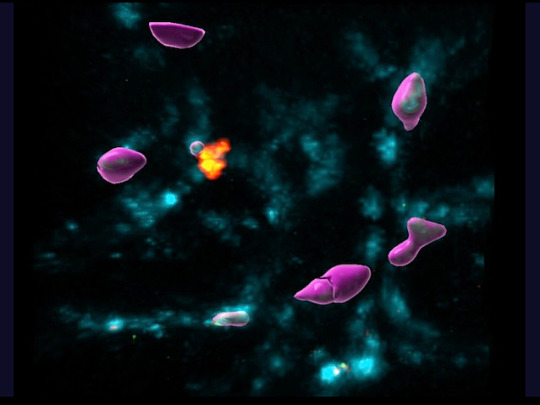
T for Tolerant
Single cell analyses and live-imaging in mouse gut reveals mechanisms underlying tolerance of the immune system's regulatory T cells to chronic bacterial infection and the intestinal niches where this takes place. Greater understanding of the disruption of tolerance which results in colitis
Read the published research article here
Still from video from work by Yisu Gu and Raquel Bartolomé-Casado, and colleagues
Kennedy Institute of Rheumatology, NDORMS, University of Oxford, Oxford and Wellcome Sanger Institute, Wellcome Genome Campus, Hinxton, Cambridge, UK
Video originally published with a Creative Commons Attribution 4.0 International (CC BY 4.0)
Published in Nature, April 2024
You can also follow BPoD on Instagram, Twitter and Facebook
#science#biomedicine#immunofluorescence#biology#immunity#immune response#colitis#inflammation#gut bacteria#microbiome
11 notes
·
View notes
Text
U-1146: what the fuck why are you helping out cancer cell
Regulatory t cell: that's oomf😭😭😭😭😭😭😭😭😭😭😭😭😭😭😭😭😭😭😭😭😭😭😭😭😭😭😭😭😭😭😭😭😭😭😭
#before she came to the realization lollll#hahaha im so funny pls laugh#she was a baddie tho so shes forgiven<33#the word oomf is so funny to me i cant stop saying it#cells at work#hataraku saibou#regulatory t cell#u1146#does cancer even have a tag
17 notes
·
View notes
Text
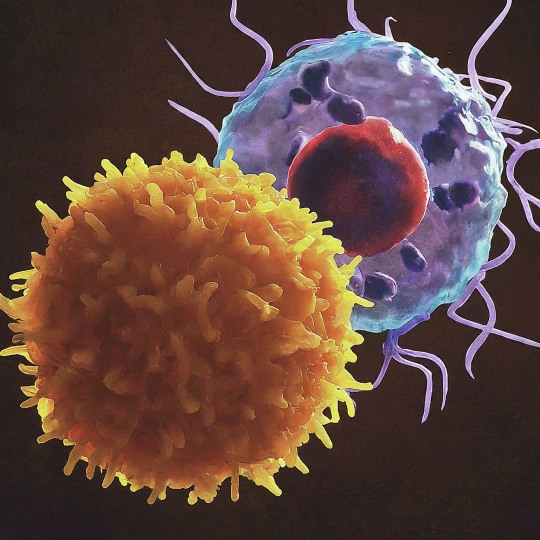
The T Cell Landscape
T cells, a critical component of the adaptive immune system, stand as the body's elite force in combatting infections and diseases. These specialized lymphocytes boast remarkable diversity, each type playing a distinct role in orchestrating a targeted and effective immune response.
T cells, like all blood cells, originate from hematopoietic stem cells residing in the bone marrow. However, their training ground lies within the thymus, a specialized organ located in the chest. Here, they undergo a rigorous selection process known as thymocyte education. During this process, immature T cells, called thymocytes, are presented with self-antigens (molecules unique to the body) by special cells. Thymocytes that bind too strongly to these self-antigens are eliminated, preventing them from attacking healthy tissues later. Only thymocytes that demonstrate the ability to recognize foreign invaders while exhibiting tolerance to self are released into the bloodstream as mature T cells.
Following this rigorous training, mature T cells exit the thymus and embark on their patrol, circulating throughout the bloodstream and lymphatic system. They remain vigilant, constantly scanning for their specific targets – antigens. Antigens are foreign molecules, such as fragments of viruses, bacteria, or even cancerous cells, that trigger the immune response.
The hallmark of a T cell is its T cell receptor (TCR), a highly specialized protein complex embedded on its surface. This receptor acts like a lock, uniquely shaped to fit a specific antigen, the "key." Each T cell develops a unique TCR capable of recognizing only a single antigen, enabling a highly specific immune response.
But how do T cells encounter these hidden antigens lurking within infected or cancerous cells? This critical role is played by antigen-presenting cells (APCs). APCs, such as macrophages and dendritic cells, engulf pathogens or abnormal cells, break them down into smaller fragments (peptides), and present them on their surface complexed with major histocompatibility complex (MHC) molecules. MHC molecules act as identification tags, allowing T cells to distinguish between "self" and "non-self." When a T cell's TCR encounters its specific antigen bound to an MHC molecule on an APC, a dance of activation begins. The T cell becomes stimulated, and a cascade of signaling events is triggered. This leads to the T cell's proliferation, producing an army of clones specifically tailored to combat the recognized threat.
T cells are not a single, monolithic entity. They comprise a diverse population, each type with a specialized function:
Helper T Cells (Th Cells):
Helper T cells, often abbreviated as Th cells, play a central role in coordinating immune responses. They express the CD4 surface marker and can recognize antigens presented by major histocompatibility complex class II (MHC-II) molecules. Subtypes of helper T cells include Th1, Th2, Th17, and regulatory T cells (Tregs), each with distinct functions and cytokine profiles.
Th1 cells mediate cellular immunity by activating macrophages and cytotoxic T cells, crucial for defense against intracellular pathogens.
Th2 cells are involved in humoral immunity, promoting B cell activation and antibody production, thus aiding in defense against extracellular parasites.
Th17 cells contribute to the immune response against extracellular bacteria and fungi, producing pro-inflammatory cytokines. Regulatory T cells (Tregs) maintain immune tolerance and prevent autoimmunity by suppressing excessive immune responses.
Cytotoxic T Cells (Tc Cells):
Cytotoxic T cells, also known as Tc cells or CD8+ T cells, are effector cells responsible for directly killing infected or aberrant cells. They recognize antigens presented by MHC class I molecules on the surface of target cells. Upon activation, cytotoxic T cells release perforin and granzymes, inducing apoptosis in target cells and eliminating the threat.
Memory T Cells:
Memory T cells are a long-lived subset of T cells that persist after the clearance of an infection. They provide rapid and enhanced immune responses upon re-exposure to the same antigen, conferring immunological memory. Memory T cells can be either central memory T cells (TCM), residing in lymphoid organs, or effector memory T cells (TEM), circulating in peripheral tissues.
γδ T Cells:
Unlike conventional αβ T cells, γδ T cells express a distinct T cell receptor (TCR) composed of γ and δ chains. They recognize non-peptide antigens, such as lipids and metabolites, and are involved in immune surveillance at epithelial barriers and responses to stress signals.
Beyond the Battlefield: The Expanding Roles of T Cells: The remarkable capabilities of T cells have opened doors for several groundbreaking applications in medicine:
Vaccines: By presenting weakened or inactivated forms of pathogens, vaccines "train" the immune system to generate memory T cells. This prepares the body to recognize and rapidly eliminate the real pathogen upon future exposure, preventing disease.
Cancer immunotherapy: CAR T-cell therapy, a revolutionary approach, genetically engineers a patient's own T cells to express chimeric antigen receptors (CARs) that recognize and target specific cancer cells. These "supercharged" T cells are then reintroduced into the patient, unleashing a potent attack against the tumor.
Autoimmune disease treatment: Researchers are exploring ways to manipulate T cells to suppress harmful immune responses that underlie autoimmune diseases like rheumatoid arthritis and multiple sclerosis.
The diverse array of T cells underscores the immune system's complexity and adaptability in mounting tailored responses against a myriad of threats. From orchestrating immune reactions to maintaining tolerance and establishing long-term immunity, T cells play multifaceted roles in safeguarding the body's health. Understanding the intricacies of T cell biology not only sheds light on immune-mediated diseases but also paves the way for developing novel therapeutic strategies harnessing the power of the immune system.
T cells represent a fascinating aspect of immunology, with their diversity and specificity driving the complexity of immune responses. As research advances, further insights into T cell biology promise to revolutionize immunotherapy and enhance our ability to combat diseases ranging from infections to cancer. By understanding and harnessing their power, we can unlock new avenues for protecting and improving human health.
#science sculpt#life science#science#molecular biology#biology#biotechnology#artists on tumblr#t cells#T helper cells#autoimmune#autoimmunity#helathcare#immunology#immunotherapy#medical care#cancer#human health#research#scientific research#the glass scientists#scientific illustration#research scientist
10 notes
·
View notes
Text
There is a huge lobby for normalization of SARS Cov 2. Entire industries depend on the public’s return to normal consumer and working behaviors. As such, the rationalizations and reassurances to the public that SARS Cov 2 is a normal seasonal Coronavirus are relentless. These are constructed like homilies and catch-phrases, such as “we must learn to live with it,” and, “it’s endemic,” with the implication of its endemicity referring to the abandonment of efforts which acknowledge its existence, such as testing.
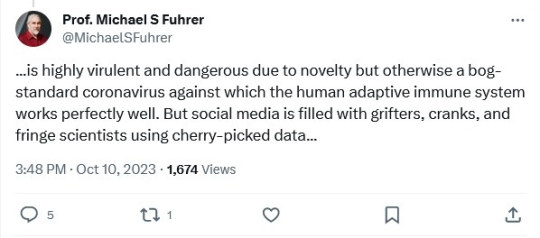
It is a complete misconception that introduction of a virus to the immune system makes subsequent infections like a common cold, and that virulence is due to novelty. If nerves, organs, and immune systems could speak, they would tell a tale of exceptional inflammation, aging, and death, which we must turn to science to hear. Professor Fuhrer would be taken aback to find there are efforts to examine specific mechanisms which tell another tale than his own.
Here, I will give you, the reader, clear enumerations where SARS Cov 2 is unlike a common cold.
SARS Cov 2 triggers a unique, long-lived inflammatory overreaction unseen in Sepsis and influenza. https://genomemedicine.biomedcentral.com/articles/10.1186/s13073-023-01227-x
It caused cells of the immune system to react in a way to create further inflammation and activation of the immune system for an extended amount of time. For technical facets of this, please see the paper.
SARS Cov 2 sends T cells into the brain while lethal influenza does not.

SARS Cov 2 directly causes autoimmunity by reprogramming a special type of T cell called the T regulatory cell, which has never been observed before. https://www.frontiersin.org/articles/10.3389/fimmu.2020.589380/full
The human genetic line has not propagated any sarbecovirus elements therefore never has faced Sarbecovirus infection to the extent to evolutionarily adapt, except in the unlikely theoretical possibility of extremely negative selection (meaning infected humans did not create progeny.)
There are more exceptional facets but these are simple and digestible. There is also more to write about but I must make a confession. The status quo has morphed in such a way as to browbeat scientists into disavowing a harsh reality in order to acquiesce to corporate and business interests. As we see the average life expectancy decline, we have been left intellectually out in the cold. The truth tellers have been assaulted and crushed, and the individuals that comprise the public, in denial, will put off the realization of a below 70s life expectancy until each one approaches retirement in piecemeal, just as all the grains of sand in an hourglass do not fall at once.
21 notes
·
View notes